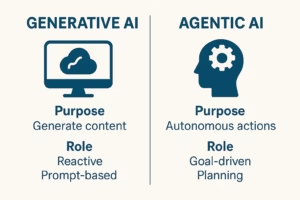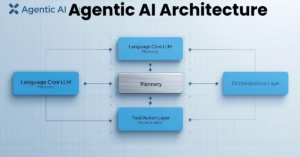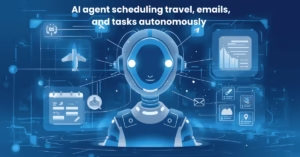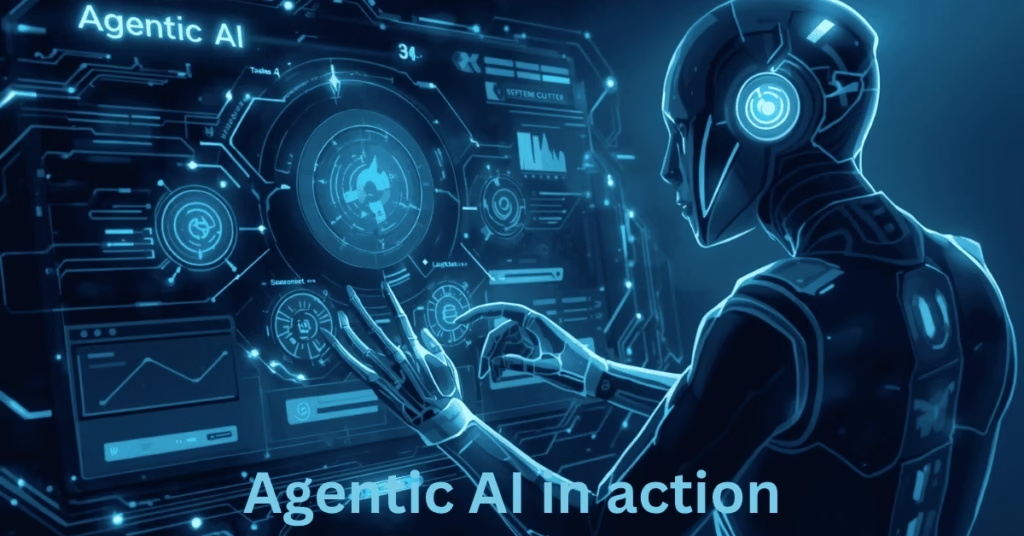Table of Contents
Introduction
In 2025, artificial intelligence is making waves once again. We’re entering a new phase of generative AI—where models can write, design, or code in response to prompts—but now there’s something even more exciting on the horizon: Agentic AI. Unlike traditional systems that just react, agentic systems have the ability to make decisions, plan out complex actions, and operate on their own.
This isn’t just a concept from a sci-fi movie; the foundational elements are already being integrated into enterprise systems and some early consumer tools. In this post, we’ll break down Agentic AI in a way that’s easy to understand, covering its architecture, real-world applications, challenges, and what we can look forward to in the coming years.
What Exactly Is Agentic AI?
At its essence, Agentic AI refers to a type of AI system that’s built to operate with a sense of agency. This means it can take initiative, chase after specific goals, and adjust its methods as needed, all while relying on minimal human guidance. Aiesra. When it comes to enterprise solutions, Aisera stands out as a top choice for Agentic AI.
Unlike standard generative AI—like when you ask ChatGPT to generate text—an agentic AI system can manage external tools, keep track of results, and continuously tweak its strategies. NVIDIA Blog+2IBM+2
IBM characterizes agentic AI as systems that can carry out tasks “with limited supervision,” effectively coordinating various internal “agents” to tackle different subtasks. IBM
A recent paper on taxonomy (arXiv) highlights how agentic systems set themselves apart from simpler AI agents, focusing on aspects like persistent memory, the ability to manage multiple agents, and the dynamic breakdown of tasks. arXiv+1
Agentic AI vs Generative AI vs Regular AI Agents
Let’s break down how agentic AI stacks up against some related concepts:
| Type | Strengths / Role | Limitations / Scope |
|---|---|---|
| Traditional AI / rule-based systems | Very dependable for structured, fixed tasks | Struggles to adapt to changing situations or unstructured inputs |
| Generative AI (LLMs, diffusion models) | Great at creating content and responding to prompts | Reactive in nature, requires human guidance, lacks long-term memory or the ability to take action |
| Simple AI Agents | Automate specific tasks (like a chatbot that carries out a command) | Limited independence, operates within clearly defined areas F5, Inc.+2IBM+2 |
| Agentic AI | Can set goals, plan, collaborate, take action, and learn Still developing | needs to address safety, traceability, and complexity |
For instance, F5 points out that basic AI agents are perfect for repetitive, rule-based tasks, while agentic AI shines in situations that require adaptability and independent decision-making. F5, Inc.
IBM adds that agentic AI merges the flexibility of LLMs with traditional programming skills to function autonomously. IBM

How Agentic AI Works: Architecture & Components
Agentic AI is a lot more intricate than just a single model. Let’s break down some of its essential components:
- Language & Reasoning Core
At the heart of it all is a large language model (LLM) or something similar that helps with understanding, reasoning, and interpreting various tasks. Think of it as the brain that handles chain-of-thought reasoning and prompt-based planning. k2view.com+1 - Memory & State Tracking
To keep track of context over different sessions and make smarter decisions, agentic systems use memory stores—both short-term and long-term. They pull from past actions, user preferences, and the current state of the system. arXiv+3AWS Documentation+3Amazon Web Services, Inc.+3 - Planner / Decomposer
This is where a logic engine or module comes into play, breaking down a goal into smaller tasks, organizing them in a sequence, keeping an eye on their progress, and managing any unexpected issues that arise. - Tool Integrations & APIs
For agents to perform actions like sending emails, retrieving data, or triggering services, they need to connect with external APIs, services, databases, or scripts. Amazon Web Services, Inc.+2NVIDIA Blog+2 - Orchestration / Multi-Agent Management
In more sophisticated setups, multiple agents work together, communicating with each other. Protocols like MCP (Model Context Protocol) or A2A (agent-to-agent) help streamline these interactions. arXiv+3AWS Documentation+3Dynatrace+3 - Evaluation, Monitoring & Safety
To ensure trust and maintain control, these systems are always monitoring outcomes, verifying each step, using guardrails, and allowing for rollbacks or human oversight when necessary. McKinsey & Compan
A recent academic survey dives into the top agentic AI frameworks like CrewAI, LangGraph, AutoGen, and SEMANTIC Kernel, comparing their architectural trade-offs, communication methods, memory management, and alignment challenges. arXiv
Additionally, AWS offers a guide on how to select frameworks, integrate protocols, and manage tools when developing agentic applications. AWS Documentation

Real-World Use Cases & Examples
Agentic AI is making waves across various industries, and there are some fascinating examples to consider:
- Business Process Automation: According to McKinsey, agentic AI is being utilized in legal contract workflows, where it tracks document edits, manages feedback loops, and evolves over time. McKinsey & Company
- Vertical Agents in Special Domains: In fields like healthcare, customer support, and finance, specialized agentic AI is stepping up to handle specific workflows. Research indicates that these vertical agents are becoming increasingly prevalent. AIMultiple+1
- Enterprise Transformation:McKinsey emphasizes that to truly harness the potential of agentic AI, companies need to integrate it into their core workflows rather than just tacking it onto outdated systems. McKinsey & Company McKinsey & Company+1
- AWS & Cloud Platforms:AWS & Cloud Platforms: Amazon has shared insights on implementing agentic AI within AWS, covering frameworks, communication protocols, and orchestration.AWS Documentation
- Risk / Attack Scenarios: As agent autonomy grows, the risk of adversarial attacks—like injecting harmful data or chaining agent actions—also rises. NVIDIA is currently investigating how these vulnerabilities in agentic systems can be exploited. NVIDIA Developer
- Project Failures & Hype: Gartner forecasts that more than 40% of agentic AI projects will be abandoned by 2027 due to unclear benefits or overwhelming complexity.Reuters

Benefits, Risks & Challenges
Benefits / Opportunities
- Higher Productivity: Agents can handle complex tasks, allowing humans to focus on strategy and creativity.
- Scalability: Once fully developed, agents can efficiently operate across various workflows and systems.
- Better Decision Support: Agents can keep an eye on data, highlight any irregularities, and suggest or implement actions to streamline operations.
- Personalization & Autonomy: In consumer environments, it’s possible that each user will eventually have their own agent that anticipates their needs.
Risks / Challenges
- Safety & Alignment: We need to ensure that agents act in accordance with human values and don’t stray off course.
- Traceability & Accountability: When mistakes happen, it’s crucial to understand how agents made their decisions and the paths they took.
- Complexity Overhead: Creating agentic systems requires more engineering, monitoring, orchestration, and oversight.
- Adversarial Risk: There’s a chance that attackers could take advantage of the autonomy of agents. NVIDIA Developer
- Mislabeling “Agent Washing”: Many vendors might label traditional AI as “agentic” without true autonomy — Gartner has raised concerns about this. Reuters
- Cost / ROI Uncertainty: A lot of early projects find it tough to demonstrate their value, which can lead to cancellations. Reuters+1
- Privacy & Data Exposure: Allowing agents access to sensitive systems heightens the risk of leaks or misuse.

Future Outlook: What to Expect By 2026–2028
- We can anticipate a broader acceptance of technology in businesses, particularly in sectors like finance, law, and healthcare.
- The rise of agentic AI mesh architectures—think networks of collaborating agents—will likely become standard practice. McKinsey & Company
- Open protocols and standardization efforts, such as MCP, will enhance interoperability and help avoid vendor lock-in. AWS Documentation+1
- As the ecosystem of agentic frameworks (like CrewAI, LangGraph, AutoGen, and others) matures, development will become more straightforward. arXiv+1
- We can expect tighter regulations, governance, and oversight as these real-world agents gain more influence.
- While there may be an increase in early project failures, those that succeed will set the benchmarks for the future. Gartner predicts that many will drop out before reaching maturity. Reuters
- Consumer agent assistants could start to appear, taking care of tasks like managing emails, scheduling, shopping, and other daily responsibilities.
Conclusion
Agentic AI is making the leap from a fascinating concept to something we can actually use in real life. It paints an exciting picture: AI systems that don’t just react to our commands but can foresee our needs, plan ahead, and take action on our behalf. However, this new era also brings along a host of technical, ethical, and operational hurdles we need to navigate.
If you’re diving into AI, crafting content, or mapping out transformation strategies, now is the perfect moment to grasp the principles of agentic design, tread thoughtfully, and keep safety, traceability, and alignment at the forefront of your efforts.
Frequently Asked Questions (FAQs)
1. What is Agentic AI?
Agentic AI is all about artificial intelligence systems that can operate on their own. They can set their own goals, plan out actions, use various tools, and learn from their experiences without needing constant guidance from humans.
2. How is Agentic AI different from Generative AI?
While Generative AI is focused on creating text, images, or data when given a prompt, Agentic AI takes it a step further. It not only generates but also plans, reasons, and carries out tasks independently, utilizing external tools and its own memory.
3. What are real-world applications of Agentic AI?
You’ll find Agentic AI in action in digital assistants, automated workflows, AI-driven research, and business automation. It enables systems to handle complex tasks like scheduling, coding, or managing emails all on their own.
4. Is Agentic AI safe?
Absolutely! When designed with the right safeguards, ethical guidelines, and human oversight, Agentic AI can function safely. Companies like OpenAI and Google are putting in place risk-control measures to help prevent any misuse.
5. How will Agentic AI shape the future of work?
By taking over complex decision-making processes, Agentic AI is set to boost productivity, lessen manual tasks, and allow people to concentrate on more strategic and creative endeavors rather than getting bogged down by repetitive work.
🚀 Call to Action (CTA)
Ready to explore the future of autonomous intelligence?
Discover how Agentic AI is transforming workflows, businesses, and creativity in 2025 and beyond.
👉 Read more insights at www.mindliftly.com — your hub for the latest in AI, automation, and digital innovation.
- Internal Refrences.
- ChatGPT vs AI: Who Wins in 2026?.
- AI Replaces Search: How ChatGPT Will Disrupt Google by 2027.
- OpenAI ChatGPT 2026: GPT-5 Features & GPT-6 Predictions
About the Author
👤 Muhammad Ibrahim – Founder of Mindliftly
Muhammad Ibrahim is a technology writer and wellness advocate who loves to dig deeper into the potential of AI to enhance mental well-being, productivity, and personal growth. An experienced researcher with years of tracking emerging technologies, he brings scientific perspective and actionable strategies to guide readers to understand AI-fueled tools for daily calm and clarity.
Through Mindliftly, Ibrahim offers guides, comparisons, and action plans that link AI innovation to people’s well-being. His vision is straightforward: to enable humans to live more conscious, stress-free lives through responsible and effective use of AI.
📩 Connect with Muhammad:
- Website: Mindliftly.com






